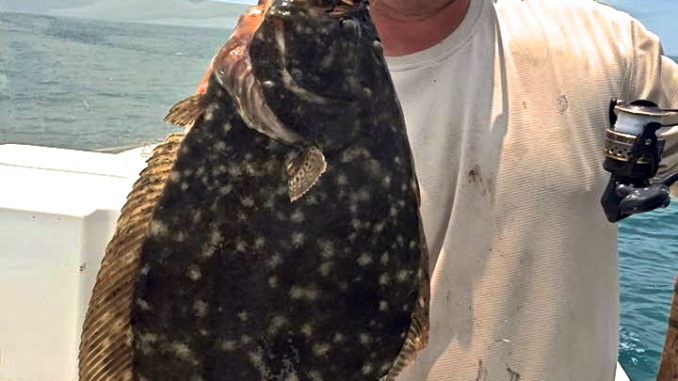
Hot inshore water often moves doormats out of inlets and off the beach
When high inshore water temperatures have you asking where the big flounder have gone, Capt. Wayne Crisco of Hampstead has the answer. According to Crisco, doormat flounder often leave their inshore hangouts when temperatures spike, opting for more comfortable ocean water and setting up near artificial reefs and ledges. Here are some of his tips for scoring a heavy limit.
Where to go. “I fish a lot of (artificial reefs), but any kind of live bottom that has a little structure and some bait, you’re apt to find flounder nearby,” said Crisco (910-465-0611), who runs Last Resort Charters. “A lot of the places you would target for kingfish, you can flounder fish: Surf City ledge, Diver’s Rock – the popular places that people bottom-fish, you can flounder fish.
While maps with GPS coordinates for reefs are readily available and a great place to start, Crisco advises to keep your eyes open. “I watch my depth finder,” he said. “There might be a good spot right outside the inlet. It doesn’t have to be a wreck, it can be one little ledge that drops off 2 feet or less, and there might be 15 to 20 fish on it.”
How to set up. Crisco admits that precision anchoring is critical to success, and often where the biggest mistakes are made. “It’s not a necessity to anchor up right over the structure,” he said. “Flounder won’t stack up right on top; they’ll be around the outside edges.
“I carry a lot of rope and make test drops with my bait until I find the fish, letting out 15 to 20 feet of line at a time,” said Crisco, who notes that flounder will not move very far a meal. “They use the reef or a ledge as an ambush point and wait for the mullet to swim by.”
The moratorium on black sea bass has also added a new challenge. “They’ve made a big comeback, and flounder are not going to lay under 10,000 sea bass,” said Crisco. “I may have to move 2 or 3 times to get away from them, but that’s normally when you find more flounder.”
What to use. “I like a 2-ounce Betts Flounder Fanatic bucktail tipped with either a 5-inch Gulp swimming mullet or live bait. Pogies (menhaden) will work, but I prefer mullet,” said Crisco. “If I’m around a lot of structure, I’ll use a Carolina rig with 1-ounce weight, an 8- to 10-inch leader, and a No. 1 Kahle hook. It’s more economical than losing bucktails.
“If I’m fishing live bait, I use the current,” he said. “Throw it out with the tide and let it sweep through the area. When you’re bucktailing, it’s more like vertical jigging. You don’t want to fish a ripping tide, but you don’t want a slack tide either.”




Be the first to comment